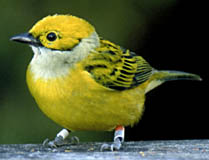
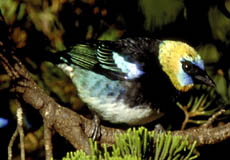
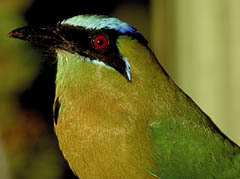
Click on any of the images in this document (including this one) to get a larger version. I've tried to put images where they belong in the text, but some do not really belong anywhere, so I stuffed them in at random, basically trying to break up large runs of text-only material.
Most of the photos here were taken with a Nikon F4 and a Nikon
300 f/4 lens mounted on a small Gitzo tripod.
When it happened for the third time, I had finally learned what to do -- you stop, relax, take a drink of water, and tell yourself, "You don't have to get there in a hurry -- you just have to get there."
I was completely surrounded by dense secondary undergrowth that seemed impenetrable in all directions, but I knew it wasn't since I had obviously gotten to where I was. The vines seemed to know how to wrap themselves around my legs, I had a nasty spine from a palm tree broken off in my left thumb, there was moss in my hair and beard, I was sweating like a pig, and there was no evidence of a break in the jungle.
Since my last meltdown I had methodically plowed ahead for fifteen minutes before becoming infuriated with the tangle. If only I had a machete.
But I was certain of one thing -- this was the last f**king forest patch I was ever going to try to measure. Of course, I was wrong about that, too ...
This year, my wife Ellyn and I were planning to spend one week in Costa Rica as tourists, basically looking for birds, and then we would spend a week at the field station for the Organization of Tropical Studies (OTS) at Las Cruces, which is near the Panamanian border that the southeast end of the country and includes as part of it the Wilson Botanical Garden. There we would do volunteer work as amateur biologists for our friends in the Stanford Center for Conservation Biology. Then Ellyn would return home, and I would remain for one additional week, helping one of the biologists (Sallie) on her project at the other end of the country, near Palo Verde.
We weren't exactly sure what the volunteer work would entail, but we
knew it would be hard work, interesting, and fun -- we had done the
same thing four or five times before. Volunteering for the Stanford
group is sort of like doing Earthwatch projects (you can read about
some of them by clicking on the appropriate links under "Travel
Stories" on my home page) except that with
the Stanford group you're guaranteed that there won't be any assholes,
and there will be a lot more alcohol involved. (Well, more alcohol
except maybe for the Earthwatch
butterfly trip to Ecuador. And there really aren't many assholes
on Earthwatch trips -- I've been on six trips, and there has only
been one. But on Earthwatch trips you do get tossed in with unknown
folks, and you tend to get along well with some and the others are
neutral -- on the Stanford trips, I've gotten along very well with
everyone.)


Ellyn and I were assured an entertaining trip in Las Cruces and Palo Verde, but we had to amuse ourselves for the first few days so we poked around on the web looking for a suitable place to be full-blown tourists. We finally settled on the Tarcol Lodge on the Pacific coast of the country. It would be great for birds and other wildlife, since it had so many different habitats nearby. It's located on the estuary of the Tarcol River, there are large mangrove swamps around it, and it's only a few kilometers from the Carara National Park which contains a pretty interesting collection of dry to moist primary and secondary forest.
One of the reasons we picked it was that on our very first trip to Costa Rica, we were meant to visit Carara, but the tour was badly planned, and we spent all day in a bus getting there, only to arrive just after it closed. Of course, we had to get on the bus early the next morning to make it to the next site. But that evening we stood on the bridge over the Tarcol river and I saw my first wild Scarlet Macaws flying overhead, and the river itself was filled with crocodiles. In fact, there are so many Scarlet Macaws in Carara that after a few days, a birdwatcher who's only interested in "listing" his sightings would call the Scarlet Macaw a "trash bird".
So we made reservations (the ones at Las Cruces were a mess -- we had to stay in a hotel outside the station for the first two nights), and waited for February 11 to arrive when we'd finally get on the plane.
As we had done twice before (see Drug Running), Ellyn spent the last couple of weeks gathering various drugs and other medical supplies from various sources to give to the county hospital in the town of San Vito near the Las Cruces station. We had an enormous pile of boxes of drugs in our living room, all packed in what seemed to be the most inefficient manner possible -- large bottles containing one or two pills each, typically -- but we were able to repackage everything and fit it into a couple of giant duffle bags.
I don't know if I'm unusual, but I find that airlines always seem to handle delays in the most infuriating possible way. If they tell you the delay will be ten minutes, it will be twenty, or half an hour; if they tell you half an hour, it will probably be two, but every forty minutes or so, the'll tell you it's another fifteen. They probably give an optimistic estimate for a couple of reasons: one, so that people are available when the flight takes off, and two, if they tell you there's a two hour delay, you may change your flight to a competing airline.
There's nothing they can do about the second reason, but airports are full of television monitors that announce flight status, and when it says "boarding", you've got a half hour or so before the doors close, and even in the giant Dallas airport it takes at most ten minutes to get from anywhere to anywhere using the train.
Coming home at the end of the trip there was a spectacularly outrageous example of what I outlined above. We'd already waited nearly an hour, and we were told that "The plane is ready to board, but we're waiting for the flight crew. They have just gotten off their delayed flight from La Guardia, and we'll begin boarding as soon as they can get across the airport. It took forty five minutes for the flight crew to arrive.
Anyway, we got the usual series of "just a little bit longer" announcements, and finally, about two and a half hours late, we boarded the airplane. We pushed back from the gate, and the captain announced that the same warning light that had caused the first delay was on again, so we returned to the gate and got off.
Obviously, I'm in favor of safe airplanes, and was happy not to fly with a warning light on -- I just wish the airlines would be more honest about their delay estimates. And it's not just American Airlines -- they're all just as bad. It's just that the estimates are always much shorter than the real delay, and even though I know this, I still get pissed off.
So by then it was getting pretty late, and we were told that we'd just switch to another airplane, and the one they've selected will arrive in forty five minutes. Then, of course, we'll wait for that plane to get unloaded, for all our luggage to be transferred, for the cabin to be cleaned out, et cetera, and we're talking another hour and a half, at least.
Since it was a dinner flight and it was already 9:00 pm or so, they told us to go ahead and get dinner, on them, in the airport. The available restaurant selections included McDonald's and a couple of others that seemed even worse. Now airplane food is bad enough, but McDonald's is worse, so Ellyn and I skipped the free meal and went to one of the nicer airport restaurants. (Wow! I never thought I'd ever use the word "nicer" in the same sentence as "airport restaurant", but there -- it just happened.)
Anyway, a couple of hours later we finally took off, and had an uneventful flight to Costa Rica, arriving at about 2:30 am. Customs and immigration were quick, probably because those folks also wanted to go home too, but it wasn't all that quick, and when we finally got to our hotel, it was 4:00 am. The van to take us to Tarcol Lodge would be there in 5 hours. As in the past, nobody questioned the two giant bags of drugs we brought into the country.
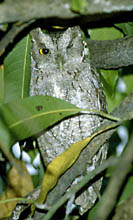
The drive from San José to the Tarcol Lodge takes two to three hours, depending on the traffic, so we arrived in time for lunch. During the middle of the day, birding is generally terrible, and most birders just take a siesta at midday, so given our sleep debt, that's exactly what we did. Then late in the afternoon we took off to see what we could find.
The Tarcol Lodge caters to birdwatchers, and they have a full-time guide. While we were there, the guide was César, and you couldn't ask for anyone better. Over the course of our Tarcol stay we saw almost 160 birds. The other guests were much more serious birders than we are, but it was fun to go out with them. Ken (a university professor from Canada) and his wife Lily were quite good at it. Lily was amazingly good at spotting birds, but had a hard time explaining where they were: "It's in the tree facing you!", for example.
I confess, however, that Ellyn and I are beginning to keep lists of the birds we've seen (to prove it, the bird list for this trip is at the end of this document), and I'm afraid that it's just going to be a matter of time before we're known as full-blown "twitchers", as the nut-case birders are called. This was drawn to my attention much later in the trip when I'd been pointing out birds all day to the woman I was working with and then made a comment to the effect that I wasn't really a birder. Her reply was, "Well, you're sure doing a good imitation of one."
Ken also had a great technique for learning the birds which I should emulate, but am too lazy. When a new bird was spotted, he instructed César not to tell him what it was, and he'd try to figure it out himself, checking his answer back with César when he was done. This is the exact opposite of what most birders want, and César told me it was tough for him since he was so used to blurting out the names the instant he found the birds.
The only minor disadavntage to me was that when César was looking for a bird (since he'd either heard it, or had some good reason to expect one to be there), I didn't really know where to look -- if I know it's a wren, I'll look in completely different places and for a completely different-sized bird than if I know it's a toucan. At least I could see generally where César was looking, but I was seldom sure of the size or color of the creature I was looking for. On the other hand, it really didn't make much difference; if César and I started looking for the same bird at the same time, César would find it first 99% of the time anyway, so my additional eyes were of almost no consequence.
César knew the birds cold, but he was well-trained in other areas of biology as well. On our final trip out with him, just Ellyn and I (and Mabel) were there, and we asked all sorts of questions about non-bird biology, and got good answers every time.
For the first couple of days we were there, César's girlfriend Andrea was with him, and she was also an amazingly good source of biological information. She was still at the University of Costa Rica, and had to leave a couple of days before we did to return to classes. Together, César and Andrea made our stay at Tarcol a great experience. Mabel was a lot of fun to talk to as well.
The nicest trick I learned from César while I was at the Tarcol
Lodge is that the call of the Ferruginous Pygmy-Owl is not
particularly hard to imitate, and many of the small birds, like
warblers, are attracted to it, in a sense. The owl eats these small
birds, but they are almost impossible for it to catch, if they know
it's around. Consequently, if one of the smaller birds notices the
presence of a Pygmy-Owl, it will start an alarm call, and will be
joined by all the other small birds in the vicinity. The cacophany of
alarm calls lets all the little birds know, "There's an owl around; be
careful!". So all you need to do to see a lot of warblers if you're
in the right place is to give the call of the Ferruginous Pygmy-Owl.
We went to Carara on two days, went out in the late afternoon
and early evening a couple of times to look for owls, took a
boat ride through the mangroves, hiked in the mangroves (well,
in the mud near them), hiked on nearby trails, and took a
ride up the hill behind the lodge to look for raptors.
The story that sticks best in my mind concerned a monkey project. The biologists were tracking monkeys in the rainforest, and from time to time they needed to capture the monkeys for tests. The difficultly, of course, is that monkeys can travel fairly rapidly through the treetops, and they are not constrained to follow a route that's even vaguely related to trails on the ground.
Tracking them involves lots of cross-country running, up and down steep hills, and the ever-present danger of crashing against a spine-covered tree, of breaking your leg or neck, and of getting bitten by a poisonous snake -- all in 100% humidity and tropical heat.
The monkeys were captured by shooting them with a dart containing some anesthetic, and since the highest priority was to protect the monkeys as well as possible, the group carried huge backpacks full of medical equipment to take care of any problems the monkeys might have as a result of the injections. Thus all the running above was done carrying big loads.
Running for hours in 100% humidity and high temperatures in a very rustic field site generated not only a lot of falls, but a lot of sweat, and the rusticity made it basically impossible to bathe, so after just a couple of days, the researchers became quite fragrant. It's such hard work that after a couple of days everyone had a wild look in their eyes, and Andrea reported that when they did happen to come across "civilization", mothers would scramble to get their children inside -- they were faced with dirt-covered, wild-eyed, stinking semi-humans carrying heavy packs, chasing monkeys cross-country, and to top it all off, carrying a gun (to shoot darts).
Andrea reported the psychological damage caused to a new (human) recruit to the project who showed up on his first day and was told his job was to carry a veterinary cage for the monkeys. A look of horror appeared in his eyes when he found that "carrying the cage" involved running with it up and down steep hills in the rainforest. On the first sprint, he slipped, and he and the cage wound up tangled with one of the palms covered with killer spines. Apparently within an hour of starting, he was reduced to tears.
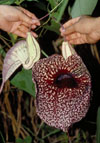
Besides, I'd already seen the King Vulture in Ecuador, so it wouldn't even be a "life bird" for me. (You see a life bird when you see a bird for the first time in your life.)
Unfortunately (or fortunately, if your main interest in life is to see vultures), from the deck of the lodge we had a fantastic view of the dead cow a couple of hundred meters away, so we could watch all the proceedings from the comfort of our deck chairs.
It took the Black Vultures at least a day before they found it, and even then, they didn't seem to do much, other than to gather in the trees above it. We never did see a King Vulture at the carcass (but we did see one later, when César took us up the hill to look for raptors -- it was Ellyn's first).
The day after the vultures found the body, we saw some poor guy trying to haul the body into the water with his bare hands. Amazingly, he was able to do so, but was unable to tow it very far since the carcass must have weighed nearly a half ton, and was already beginning to bloat up. His plan was probably to have the outgoing tide take it out to sea, or at least far enough out into the estuary that the crocodiles (or which there were many) would have a good crack at it. Being the eternal pessimist, I, of course, had nightmarish visions of a rising tide depositing the body 10 meters from the lodge.
But the guy apparently guessed right -- the cow was gone the next day, and I couldn't find any sign of it when I scanned the entire estuary with my binoculars. I suspect that a lot of it wound up in the stomachs of the crocs, but I don't know.
Ellyn and I did our first day as pure birders, carrying only binoculars, but on the second day I decided I'd be primarily a photographer instead, so I hauled along my camera, longest lens, tripod, and flash. I was also carrying binoculars, but it was clumsy to get to them in a hurry. In spite of this, I think I only missed a couple of birds that I would have seen had I not been carrying the camera -- and a lucky thing it is, too. Without the camera, this would be a pretty boring story -- all text and no pictures. I wish I'd carried all my gear on the first day as well, since on that day we had repeated fantastic views of the Scarlet Macaw, and all I had was a 105 mm lens (and you'll notice, by looking carefully, that there are no photos of Scarlet Macaws on this page).
I enjoyed sitting on the deck of the lodge -- we had a great
view of the estuary, and at almost any time you wanted, you
could see Ospreys circling overhead, occasionally diving into
the water to capture fish. There were hundreds of Brown
Pelicans and Magnificent Frigatebirds as well. And of course
if the tide was low you could see crocodiles out on the
sandbars.
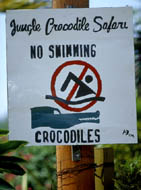
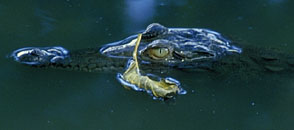
Also visible from the deck was a sort of bird feeder that attracted an interesting collection of Great-tailed Grackles, Rufous-naped wrens, Prothonotary Warblers, Great Kiskadees, Hoffmann's Woodpeckers, and many others. In fact, one day somebody's pet dog came by, put his paws up on the feeder, and proceeded to wolf down all the bird food.
One interesting thing I saw at the feeder was when a Great Kiskadee took a fairly large chunk of bread from it. Kiskadees are flycatchers, and you typically see them eating relatively large insects like moths or bees, so when it got the bread, the first thing it did was to bash it repeatedly against a branch to "kill" it.
Each day after dinner we'd haul out our lists to remind ourselves what we'd seen during the day. We'd then "check off" those birds, in true fanatical birder (twitcher) style. Since Ellyn and I left shortly after noon on the final day, we went over the lists after lunch. We got to "Osprey", and I realized that I hadn't seen one that day (we'd been inland, looking for raptors up in the hills). I said, "I'll just go ahead and check it off; after we're done, I'll go out on the deck and 'see' it", since I was so confident of finding one. (I did.)
The next morning we were to pick up a car for the Stanford team and drive it across the country to the OTS station at Las Cruces. I wasn't sure what the exact logistics were -- I had planned to stop at the car rental place at the airport upon arrival, but amazingly enough, at 4:00 am, the car rental place had been closed.
So I called Alamo car rental to see if we had to go all the way out to the airport to pick it up, or whether we could just get it at the office in town. The airport is about 20 km out of town in the wrong direction, so it would sure be nice to avoid 40 km of extra travel. Of course things were completely fouled up -- the car was to be charged to Stanford, but the person at the agency claimed that the Stanford credit card number was only to "guarantee" the reservation, not to rent it, so I'd have to pay for it on my own credit card. Not only that, but only the people who picked it up and signed on the spot could drive it. (Our plan was to take the car down there so that the rest of the team could use it.)
I sent email from the hotel lobby to everyone I could think of explaining the problem and our proposed solution (that I'd just rent the car, that I'd drive it while there, and I'd return with the additional Stanford person (Sallie) who needed to drive it after I'd gone to the rental place in San José where she'd be able to sign the release) and then Ellyn and I took off for dinner.
We decided to try someplace new, and we found an ad in the hotel lobby for a place just a few blocks away were we could get a 10% discount since we were at that hotel. It was called Cafe Mundo, and served mostly Italian food. It was a pretty good meal (and it turned out that I'd eaten there before with an Earthwatch team when I did the caterpillars project), but this time with just me and Ellyn, I paid more attention to what else was going on there. It was loaded with gay couples! I'd never seen anything like it in San José (Costa Rica), and usually the gay lifestyle is not particularly welcome in Central American countries. The food was good, so on the final day of my trip I returned and verified that it wasn't just a fluke -- there were many gay couples that night as well.
When we returned to the hotel, we got a phone call, and we were told that most of the Stanford group was in San José, and that they'd try to straighten out things in the morning. And the next morning they did -- they were at the airport and signed the releases there, submitted the appropriate credit card, et cetera, and then the car was delivered to our hotel where we signed releases for ourselves. We then loaded all our junk into the van and headed south toward Panama.
The roads were in amazingly good condition -- we were told that a giant international border-to-border bicycle race had caused Costa Rica to repave large sections of the Pan American highway which is what we drove for most of the distance. About an hour from the end, however, we had to ride on a secondary highway which had its share of potholes, so things seemed more like I'd remembered them. (Due to the potholes, in Costa Rica only drunks drive in a straight line.)
Since we didn't have reservations at the OTS station for the first night, we stopped at our hotel in the town of San Vito, about 6 km north of Wilson Garden, checked in, and unloaded our gear. After a couple of showers, we drove to the garden and the entire team was there -- Paul and Gretchen, the two faculty members directing everything, Claire and Sahra, a grad student and assistant working on butterflies, and Sallie, another grad student who was working on the GIS (Geographical Information Systems -- more on this later) project. Sallie, Gretchen, and Paul had arrived just a little earlier that day. We ate at the garden, made plans for the next morning, and then went out to play our first game of "Dodge 'em" for the year.
Dodge 'em is played by walking along the highway at night, armed
only with a flashlight, trying to dodge the cars driven by drunken
drivers without diving headfirst into the bushes (and God knows
what's in the bushes) too many times. It was a very enjoyable
game, and when we finally got back, Ellyn and I drove back to
our hotel in San Vito. We weren't drunk, so we didn't try to
drive any dodge 'em players into the bushes.
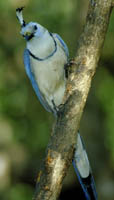
Since Claire had already been at the garden for a month, she knew exactly what was going on, and Sallie (who was in Costa Rica for the first time in her life) still needed to sort some things out with Gretchen. Thus Ellyn and I went out to help Claire on the first day, although I planned to begin helping Sallie as soon as possible to get familiar with her project.
Claire had a variety of sites where she was capturing butterflies, both in nets and in traps. She also needed to characterize the sites in terms of the vegetation in and around them, and she'd been working so hard just capturing, identifying, marking and releasing the butterflies that she hadn't even started on the characterizations, so Ellyn and I did that.
There were basically two things to do -- quadrats in the site, and a characterization of the larger areas adjacent to the site. Each site was a transect 25 meters long and 5 meters wide where all the butterflies were captured.
For the quadrats, on evenly-spaced intervals, we looked carefully at 10 particular one-meter-square regions to see what was there -- the average height of the vegetation, the number of species of flowering plants, and the number of flowers in bloom that the butterflies could use. That was pretty easy, but it also made clear some of the difficulties of doing this sort of thing. For example, if you just count flowers, the tiny ones that are almost invisible, but are very common count just as much as a giant flower that's loaded with nectar. On the other hand, it would be extremely difficult to accurately identify the various species of plants present. You'd have to be a pretty good botanist to do so, and becoming a good tropical botanist is a lifetime's work. So we just counted the flowers, and a microscopic bloom counted the same as a passion flower.
The other part -- the characterization of the adjacent areas -- was uglier. If there was a big coffee plantation or forest patch next to the site, Claire wanted to know how big it was. To figure it out, we had a tape measure 100 meters long, and of course none of the boundary angles were right angles, and nothing was remotely close to level. The worst part was that when you began, you had no idea of the overall shape, and you learned it by wandering around. With the coffee fields at least the trees weren't too high, and they were arranged in rows so it was often possible to look down a row and get some idea of the magnitude of the problem. But the fields ended in weird angles, and sometimes it wasn't even clear when the field ended -- it would just sort of peter out and gradually become bananas or just scrub.
And then there were the forest patches.
The first forest patch that Ellyn and I tried to measure was adjacent to a coffee plantation in which the butterfly transect was located. The patch looked like it was ten or twelve hectares, but of course we could only see the front. We suspected that there was a clean cutoff at the back with pasture behind it, but weren't sure, of course.
I had a GPS unit, and my plan was basically to walk around the patch, noting the coordinates at a number of points around the boundary. Then we could draw those out on paper to get an outline of the patch, and with an inclinometer (which I also borrowed) we could make some wild estimate of the average slope, and thus calculate the total surface area of the forest.
The family who managed the coffee plantation was made up of the nicest folks in the world. When we were netting butterflies, they'd bring out food for us and their child Adrian who was perhaps 10 years old would join us each day he could, and helped. He even had his own butterfly net. In fact, his mother would even wash bloodstains out of our shirts (more on that later).
As usual, Adrian followed the group to the netting site and when Ellyn and I decided to circumnavigate the patch we asked him about trails, routes, et cetera. If we'd had a grain of sense, we would have reconsidered our plan when Adrian announced that he had never been around the patch, even though he was an active ten-year-old, and the patch was basically in his backyard.
But despite my best efforts, I lost my footing while stepping into the first ravine, slipped down about a meter, and landed with a splash in a pool of muddy water at the bottom. By this time, Ellyn was having second, third, and fourth thoughts about the project, since she was wearing only tennis shoes, while Adrian and I wore rubber boots that came up to just below our knees (of course Adrian's knees were a lot closer to the ground than mine). So she decided to turn back and help Claire with the butterflies while Adrian and I worked our way around the patch.
After ten minutes of fairly hard work, we got across the ravines where we got a good view of the edge of the patch from about 50 meters away, but found that between us and the edge was an absolutely impossible ravine. So we backed up to where we'd started, and went into the patch a bit from the bottom, to see if perhaps it was easier to walk in the forest, coming out to the boundary from time to time to take readings.
I don't know what was easier -- in the patch the slopes were pretty steep, there were a lot more of the spiny "killer palms", and you couldn't see exactly where you were, but there was less tangle, and we seemed to be able to make progress, although there was a lot of backing up involved when we ran into dead-ends or hopeless tangles.
It took about a half hour to get to that spot we viewed from fifty meters away, but when we finally did, we took another GPS reading. Then back into the patch with a vague idea of coming out about 50 meters further along the patch edge. We ran into some seriously steep slopes and had to back off once again, but found a riverbed that went in the right direction. In fact it wasn't just a bed; it had a river running in it as well, but it was easier just to walk in the river than to try and walk along the bank. If Ellyn had been there in her tennis shoes I don't think she would have been pleased at all. It took another half hour to come out 50 meters further along, but now we could actually walk on pasture by the side of the patch all the way to the top.
We took a look around the back, and it did look like pasture as we'd hoped, but we chickened out on doing the complete walk-around, since we had no idea how bad it would be to get back along the far side, or even if it was possible at all. We took GPS readings and then retraced our route back, and it took one hour and forty five minutes of very strenuous hiking to make it up one edge of the patch. What was particularly discouraging was that we had only covered, as the toucan flies, about 300 meters. I was completely wiped out, and Adrian didn't look all that great, either. There was not a chance that I would go up the other side to get GPS readings that day.
From then on that day, I wasn't much good for anything, but could do the little quadrats, so that's what I did. I was really happy to get back to the lab at about 3:00. But for some reason, I was already feeling a bit perkier by 4:00 and went out to play a game of "ultimate frisbee" with Claire, Sahra, and a huge gang of the local kids on the soccer field. Due to all the sprinting during the frisbee game, the next morning I discovered the locations of all sorts of muscles that I never knew I had.
That night, Paul took all of us out to dinner in San Vito, and
afterwards, he, Gretchen, and I played an advanced game of
dodge 'em by walking the six kilometers back to the lab in
the middle of the night. There was a full moon, so it was
very nice, but after doing the patch, the frisbee, and then
the marathon dodge 'em game I was totally wiped out.

He was unable to talk, and basically looked stunned. After a few minutes, he was able to sit up, but was still completely uncommunicative, and was drooling all over the place. The people with him hadn't seen him fall and also had no idea what to do. Ellyn thought it looked like he had just had a seizure, and since we were only a few blocks from the hospital and since we had a car, we should just take him there. We moved all our junk around to make room for him in the front seat. Ellyn and one of the men who had been with him started to walk him toward the car.
Then a miracle occurred -- an ambulance passed by, we flagged them down, and I felt a lot better about letting them take care of the poor old guy. The ambulance drivers loaded him into the back, thanked us profusely, and drove away. Only after they left did Ellyn notice that her shirt was spattered with the guy's blood.
But the next site was the one in the coffee plantation managed by Adrian's family, so Ellyn asked his mother if she could borrow the sink to scrub off the blood, since she had no desire to spend the rest of the day with some stranger's blood all over her clothes.
Adrian's mom, of course, insisted on giving the shirt a thorough scrubbing and wouldn't let Ellyn lift a finger. It was all Ellyn could do to keep her from ironing the shirt.
But we knew that the director of the OTS station knew Pablo pretty well, so we sent him email asking him to contact Pablo to see if there were any supplies that he could particularly use, et cetera. We never heard from the director, either, so Ellyn just gathered whatever she could, and we hauled the whole mess to San Vito. On our first day there, we stopped at the hospital to see if we could find Pablo, and unfortunately we woke him up -- he'd been on call in the emergency room for the last 24 hours and was trying to get a bit of sleep when we arrived.
But he was really happy to see us, and had no idea we were coming -- he thought perhaps because the director was also out of town. Anyway, we dragged in our haul, handed it over, and Pablo presumably went back to sleep, but not before we had invited him to dinner. In fact, the dinner between the frisbee game and the marathon game of dodge 'em was with Pablo.
Pablo is an amazing guy, and one of the nicest people you could meet. He kills himself working at the hospital which is, of course, understaffed and undersupplied, but on the weekends he goes to San José (a 5 hour drive, although Pablo claims he can make it in 4, or even 3.5) to volunteer time in a clinic for underserved people.
It was really interesting to listen to his experiences as a physician in Costa Rica.
For example, the health care there is completely free to any citizen, and there are some surprising consequences. The most obvious one is that the people don't particularly value the services. Pablo had just had a patient with a broken leg, so he set the bones and put on a plaster cast. Within hours, the patient was back -- he'd gone wading in the river, had destroyed the cast, and needed another.
Another problem he faces is similar to what's going on in the United States, but at a different level. In the U.S., since there are so many uninsured people, many of them go to the emergency room for their primary care. That's because by law, they can't be turned away from an emergency room. So instead of what would be a relatively inexpensive visit to a clinic if one were available to them, they make a $1000 visit to an emergency room, and then don't pay for it. It would be much better to make a $100 visit to a clinic and not pay it, at least in my opinion.
In Costa Rica, the poor people use the emergency room as a source of things like soap and toilet paper. The expenses are obviously not comparable, but the visit to get soap ties up the emergency room staff and includes all the usual paperwork for them.
Another thing Pablo told us also says something about Costa Rica. As I said above, the medical system is free to "citizens", and that's stated in the constitution, but the courts have interpreted "citizen" not as "citizen of Costa Rica", but rather as "citizen of anywhere". Only men without a country can't, in theory, get free medical care, and I'll bet they could, too. So since San Vito is right next to the Panamanian border, a significant percentage of Pablo's work is with Panamanians, especially when it's time to pick crops, and the Costa Rican equivalent of our Mexican "braceros" are from Nicaragua and Panama.
We also apologized to Pablo that night for sending him extra
business in the form of the guy we'd found lying in the street
a couple of days earlier, but he said he hadn't been on duty
that day. He did know the guy, however, and said it was
almost certainly epilepsy since the guy had these attacks
relatively often. He's typical of patients everywhere who
don't follow doctors' orders well. His epilepsy is
apparently well controlled with the correct drugs, but after
taking them for awhile, he decides that since he's had no
episodes, he must be cured, and stops taking his medicine.
Then it's just a matter of time before somebody finds him
semi-conscious in the gutter.
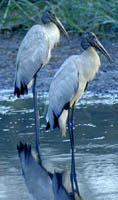
She also purchased, as a gift for Sallie, a big machete, since if you were in Costa Rica, you "obviously" needed one, despite the fact that, according to an Ecuadorian friend, "The most dangerous animal in the forest is a gringo with a machete."
After the presentation of the gift at our daily "happy hour" before dinner (and after a few beers) the conversation drifted to the subject of dogs, especially possibly rabid dogs, that one encounters while doing fieldwork on random farmers' coffee plantations, how dogs can run about three times as fast as you can, and how difficult it is to dive through a barbed-wire fence from a full-tilt sprint. Gretchen had some bad experience a few years earlier when she was bitten by a dog of unknown hydophobic status and had to obtain the requisite rabies vaccine in a hurry in Costa Rica.
But it was pointed out that with the machete, there'd be no problem -- as the dog lunged at you, you could just keep slicing through the air at the dog's feet, gradually shortening them until the dog changed its mind. If you were faced with a particularly persistent dog, this might require quite a few slices, and that in principle, you could use this technique to convert a German Shepard into a Welsh Corgi.
From then on, the machete was referred to only as a "Corgi Converter".
The stated goal of the stations is to provide researchers in tropical biology sites for their research and support in the form of rooms to stay, laboratories, meals, laundry services, et cetera. They also are to be used for education, so many classes of students in tropical biology pass through them as well. Finally, if neither of the above groups need the space, tourists can also use the facilities, although at a much higher rate. Researchers pay about $30 per night; tourists, $72 per night.
At Las Cruces, at least, this policy has had unintended consequences. Since there's so much more money to be made by housing tourists, there seems to be more than a subtle pressure to discourage research, which completely flies in the face of stated mission of the OTS -- to support tropical research and education.
Claire and Sahra had been there for a month when we arrived, and like clockwork, a new group of tourists would replace the previous one every Sunday and every Thursday. For the entire month, Claire and Sahra were the researchers staying there, together with 30 or 40 tourists.
It is a very nice place to stay, and consequently groups like Elder Hostel book them solid a year ahead, which is much more notice than most researchers can give, so the researchers are basically out of luck.
At La Selva, it's just the opposite -- tourists are discouraged, and there are lots of researchers there, so not only can they get their work done, but they can mingle with others doing similar work during mealtimes or over beers in the evenings.
I think Claire and Sahra were nearly out of their minds when we arrived, because since the station is advertised as a research station, all the tour people want to talk to "real researchers", which would be nice if there were more than two of them. The vast majority of the tourists are very nice, well-meaning people, but after about the two-hundredth "What sort of research are you doing?" question, you find yourself on the verge of a psychotic break.
In fact, while we were there, we had seven people in the research group which was enough to completely fill a table, and consequently, we were totally anti-social and ate together at every meal, hardly speaking to the tourists. (Notice now that since the first week was over and I was no longer a tourist, I feel free to dump on them.)
There are some researchers who use some of the facilities -- the garden or the lab -- but I talked to one of them last year, and asked why he wasn't staying at the garden. There were two reasons, he said. The first was that it was slightly more expensive to stay there than to find a place outside, but the main reason was that when he did stay there, whenever a large group of tourists came through and they needed extra space, the researchers were tossed out of their rooms for a few days because the station could make more money from the tourists.
I suspect that La Selva is different because of a different
director, and that, at least for a while, there won't be
serious problems of the same sort at Palo Verde since the
road to get there is so horrible that not many tourists
are willing to make the trip. In fact there are a lot of
tourists at Palo Verde, but usually only for lunch, since
they can get to a nice lodge on the other side of the
Tempisque river which, thankfully, has no bridges over it.
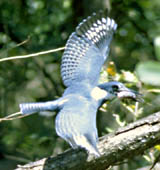
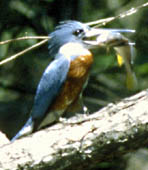
With the world as it is today, it is very difficult to find biological systems to study that have not been modified in a large way by human activity. But many biologists want to do their research in "unspoiled" environments. La Selva has a fairly large, relatively unspoiled forest, so it's a great place to go if that's what you want to study.
But that means that these "pure" biologists who study unspoiled environments are ignoring 99% of the actual biology that occurs on our planet. Obviously it's nice to learn about systems without man, but to ignore human-altered systems is to work with your head in the sand.
It may just be that 50 years ago there was a lot more unspoiled territory, so the teachers of today's biologists all learned in that environment and passed it on to their students. European biologists have a more reasonable view, since even 50 years ago, it was tough to find parts of Europe to study that were completely untouched by human activity.
There were a pair of Chestnut-mandibled Toucans and a single
piece of fruit. It wasn't clear whether one was feeding the
fruit to the other or whether they were fighting over it, but
there was some clashing of bills, the fruit dropped, and the
final result is that one of the toucans was hanging upside-down
by its feet from a tree limb, and it had the head of the other
toucan grasped in its beak. The other toucan just hung there
limply for about three minutes, at one time thrashing its
wings, but otherwise inactive. Then some more toucans of the
same sort arrived, together with some Fiery-billed Aracari (Aracari
are birds related to the toucans, but smaller). Again, there
was some jostling amoung the birds, and the upper toucan released
the lower, and the entire group flew off. Nobody in our group
had ever seen anything like it.
In fact, it was so bizarre that Paul decided that a very short paper on the interaction should be written. He'd talked to at least one extremely competent Costa Rican ornithologist (named Jim, see below) who had never heard of such a thing. Paul would write up his observations, and the rest of us would make comments.
Of course, all the witnesses saw something different. I was pretty sure that the lower toucan had its beak open and the upper one had a grip on the outside of the head and the inside of the mouth, which might be reasonable if they were fighting for the food and it had its beak inside the other's to try to grasp it. Paul was certain that the beak of the lower toucan was closed and that the upper one was gripping it from both sides of the head.
Some people thought it was an aggressive display; others that it was a feeding or grooming action. There was some disagreement about when the fruit dropped.
The whole thing reminded me of Kurosawa's famous film, "Rashomon", where the story of a crime is told by a bunch of different people -- the cop, the accused criminal, the victim, a witness, et cetera.
To be sure, we were a couple of pairs of binoculars short, so they were being handed back and forth, but it's still amazing to me how different the stories were.
My version, of course, was the only one that was completely correct.
Ellyn and I took a long tape measure and marked off the first 75 meters without any problems. Then Ellyn stood at the top, holding one end of the tape, and I took the other end down the third side for 100 meters (that's how long the tape was). It was nasty, but not nearly as bad as the forest Adrian and I had negotiated, so Ellyn came down to join me. She again remained where she was, holding one end of the tape, and I started down again.
This leg was slightly worse, but I knew I was about 200 meters down, so was getting close to the bottom. Rather than make Ellyn come through that, I told her to go back to the car, and I'd cut through at the bottom, get to the road, and then walk up the road to the car. She returned the way she'd come.
I measured off another 100 meters, and the patch was clearly thinning, so I figured I'd just cut through on the road and have a pretty good estimate of the size. What I'd omit measuring had a very tiny area, and we could even estimate that. So I plunged directly into the patch, which was just about as ugly as anything Adrian and I had done. But it was only for 20 or 30 meters, and I came out -- but not to the road.
In fact, due to curves and hills and who knows what else, it looked like we had been following a little finger of forest that stuck out of the top of the triangle, and to get a good measure, I'd have to go up to where that finger joined the next and measure the next one as well. So I went up and down the next one. But I wasn't long before I was certain something was very wrong -- this new finger was much longer than 300 meters, and by now I'd lost my sense of exactly where the road was due to various bends in the boundary of the patch.
I decided just to cut through the patch and get to the road and
give up on the measurement, since I really had no idea any more
what my distances meant. So I plunged into this second patch,
which proved to be far harder to negotiate than anything I'd
done before. I worked my way in for 30 meters and decided it
was hopeless, so I came back out to the pasture surrounding it.
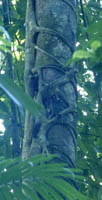
The strangler fig seeds are deposited high up in a large tree where
they germinate and send down roots. If the roots make it to the
ground, more and more are added, wrapping around the original tree.
The roots are incredibly strong, and as they get thicker and thicker,
the original tree dies, and then rots away. From time to time you
can find shells of roots from a (still living) strangler fig whose
original host has completely rotted away.
A couple of hundred meters below I could see two men working in the pasture so I walked down to them to ask directions. They told me there were a couple of possibilities -- I could just follow the pasture down to the main highway, but that would take me out nearly at the Las Cruces station, a couple of kilometers from the car, or I could cut through the forest where I'd started, and get to the dirt road that led to the car.
So I went back up and retraced my 30 meters into the patch. And kept going. It was easy to see the sun, so maintaining direction was no problem, but getting through was a total nightmare. The brush was all tangled up with vines passing through it, and it went up and down steep slopes. Besides, I was wondering what Ellyn was thinking -- I'd told her I'd just cut though to the road, and I'm sure she expected me to return in about 10 minutes.
After about 45 minutes of battling the vines, stopping from time to time to calm my temper, to drink some water, and to force myself to relax, I finally came to a banana tree, which told me that "civilization" was near -- banana trees don't grow wild. Things got better, I got to a little shack, and there was a track that led away from it in the direction I thought would lead me to the dirt road where the car was. But it went on and on, and kept turning the wrong way, and finally dumped me out on the main highway about a half kilometer from where the dirt road with the car met it. But at least I knew how to get back, and I finally met Ellyn walking down the dirt road toward the main highway about an hour and a half after I'd left her. In addition to all the plowing through jungle, I had been required to crawl though about 8 barbed-wire fences, some of which I found by feel rather than by sight.
Ellyn was convinced I'd broken a leg, or was lost, or had been bitten by a poisonous snake. I had the car keys, and she didn't know whether to go down looking for me, or to return for help. She'd finally decided on the latter plan (luckily), and I met her as she was walking out. I think I've finally learned that it's just too easy to get disoriented in the jungle, and that you should never split up. But when I was standing 100 meters below her, I was absolutely positive that the road lay 30 meters to my right.
Then and there, I decided that forest patches are evil, and that I would retire forever from the job of measuring them.
I think what happens is that farmers clear the land where it's reasonable to plant crops, but when the land is too steep, they leave it alone. Thus the remaining forest is usually in steep ravines down to streams. Since streams hook together to form a sort of tree-like structure, typical forest patches look like a bunch of fingers on a hand, or to my view, more like the twisted tentacles of a demented octupus.
But it's sure a black, ugly fire, and you can see them every day
in Palo Verde. This one happened to be only 100 meters or so from
the highway.
Sallie is working on a project to learn to do rapid land-use
assessment from satellite photos. It would be nice to take a look
at a photo of the ground and say, "This part is rice, this is
coffee, and this is sugarcane." If you can get a computer to analyze
the images, it becomes quite simple to look at a new photo and
learn how the land-use has changed since the last one. The
problem, of course, is that the satellites are pretty high up,
and if all you have is a standard color photo, it's probably
hard to figure out exactly what's down below, since, for example,
most of the crops are just going to be green.
The LANDSAT satellite circles the earth and is continuously taking photos of the ground, and these photos are more than just the usual color pictures. LANDSAT images are made in seven different frequency ranges. The visual spectrum is just one of those, but the images contain information in spectra well outside that range. Thus, two crops that both appear to be the same shade of green may radiate quite differently in the infra-red, so they can be distinguished by looking at the infra-red band.
But to figure out how the various crops radiate in the various spectra, you have to go in and find some of each kind of crop or other land usage and compare that back to what's on the satellite images. Then you know what "colors" to expect for the various usages on the photos.
Sallie's project in Costa Rica was to find large regions of land that was used in a uniform manner, and to measure precisely the location of those regions on the ground so that when she got back to Stanford, she could say, "I know that there is a rice paddy exactly here on earth; let's take a look that what the LANDSAT photos show on exactly that spot."
She also wanted to see what mixed sites look like, for example, a mixture of banana and coffee, but the main thing was to get pure sites first. I'd guess (but am not certain) that a site that's half banana and half coffee would show spectra that are intermediate between the two pure spectra of the crops.
Most of the LANDSAT images have a resolution of 30 meters, meaning
that there's one pixel of information about each chunk of ground
that's 30 meters long and 30 meters wide. Therefore you have to
find a region on the ground that's at least 90 meters long and
90 meters wide to guarantee that one pixel of the photo lies
completely within your image. There's an additional problem in that
there is some error in your measurement of ground position, so it's
better to find even larger regions.
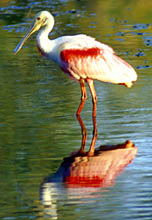
Each satellite is constantly broadcasting the exact time and also the exact details of its orbit, so effectively, its exact position. Your hand-held GPS receiver listens for the satellite signals and captures as many as it can. Because radio signals travel only at the speed of light, different distances to the satellites will be recieved at slightly shifted times.
Thus (and this is a vast simplification) by looking at the time delays, you can tell how far you are from each satellite. If you happen to know the exact time, then distances from any three satellites will give you enough information to calculate your exact position, but since you don't know the time (to within a few billionths of a second), you need a fourth satellite reading to be able to determine this.
The quality of the signals also matters -- satellites near the ground have their signals passing through much more atmosphere than those high up, so there's additional error there. But if the satellites are all in roughly the same location in the sky, even if that's high up, mathematical error in the position calculation can be high. So for any given configuration of the satellites, you can work out an error estimate for your position calculation.
And things get worse. With a decent configuration of satellites, it's possible to determine your position with an accuracy of perhaps 10 meters except that the department of defense adds errors to the signals that only they can decode with special GPS units. The idea is that our enemies won't be able to get the same accuracy from the GPS readings as our allies -- the signal is degraded for national security.
Even in peacetime, the signal is
degraded, so the best you can hope for with a single GPS reading
is an error of, on average, 100 meters. But what's really sick is
that the only time the defense department ever turned off their
scrambling was during the Persian Gulf war. They had neglected to
build enough of the decoding GPS recievers, so their only
solution was to equip the soldiers with civilian units and to
turn off the "selected availability" scrambling. I heard that
during the war, hundreds of scientists rushed to their field sites
with GPS units to get the first accurate measurements they could.
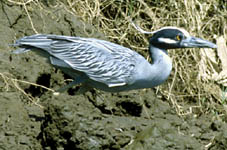
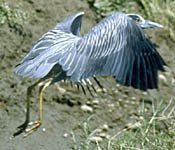
One is simply to take a whole bunch of readings at the same location, and average all the positions you get. Since the scrambling is unbiased over a long enough period of time, the average of a large number of readings will be a much better estimate of your true position. Unfortunately, to get down to 10 meter accuracy, you'd probably have to collect readings for ten minutes, which would rapidly fill up the computer memory on the GPS unit, and would require 40 minutes of standing in place to measure a single square patch. When she was at Stanford planning the project, Sallie decided that in the 5 or 6 dates in each region she'd like to measure about 100 squares, and with 40 minutes at each site plus travel time, et cetera, we'd have to be awake and working for 24 hours each day to come even close.
(In reality, we never came close to 100 sites -- we could do about 8 on a good day; we did 9 on our best day, and had a lot of 7 site days. The problem was that it was difficult to find suitable sites, and it took quite a bit of time to drive between them.)
A better solution is differential GPS. If you have a standard civilian GPS unit at a point whose location you know exactly, it can take the satellite readings and work backwards to figure out how much the time delays have been scrambled. Those delays are then used by a nearby unit to correct the readings, and it the other unit is nearby, it can have, effectively, unscrambled data with the same accuracy that the defense department's units get. "Nearby" can be hundreds of kilometers with only a slight degradation of positon accuracy, so Sallie had arranged for such a differential unit to be set up at the OTS station at La Selva that's located approximately the middle of the country.
So we just recorded our degraded signals, and when Sallie returned home, she would also have the corrections from La Selva and could correct all the readings we took in the field. In addition, even with the improved accuracy given by differential GPS (DGPS), it doesn't hurt to average some readings for even better accuracy, so we tried to take at least 80 readings (at one per second) at each corner of our squares.
We did a bunch of the coffee plantations that I was familiar with because they had butterfly sites in them, and then we decided to try some large pastures. Gretchen told us that out along the "Fila Road" there were a lot of big pastures, so we set off for that. The Fila road is a dirt track that leaves the main highway a few hundred meters from the garden. Most of it requires 4-wheel drive, and it climbs up to a ridge above the garden.
Gretchen was right; there were a lot of good sites along the road, and we did the first two without a hitch. But it's complicated -- when you stop you've got to haul out all your equipment -- the GPS unit, map, notebook, compass, inclinometer, camera, and whatever else you think you might need. Since we were just getting started, we didn't have everything down to a system yet, and it was a big scramble each time before we took off to make sure we had everything we needed.
On the right is a photo of Sallie on the Fila road. She's still
smiling because she thinks the key is in my pocket; not locked
inside the car.
Well, there was nothing to do but walk back toward the garden. And there was some chance that we could hitch-hike, although there was very little traffic on the road. We were also pretty certain that we'd miss lunch since we figured that we'd be walking for at least an hour.
Only one truck passed us, and it was going the wrong way. We stopped it and made sure from the driver that we were taking the most reasonable route home, and he told us that after he made his delivery he'd pick us up on his return if we were still walking. But it was a long, hot walk since it was noon and we'd left the water bottles locked in the car.
It did take an hour to get to the station, and the truck driver apparently took longer to make his delivery than he thought, but they'd saved lunch for us, and after drinking about a gallon of water each, we porked down lunch as well. Then we asked the staff at the station about how to get into the car. They called a locksmith in San Vito who said he'd be at the station in about a half hour. The people in the main office would call us at our room as soon as he arrived.
After about 45 minutes, we hadn't heard anything so we walked to the main office in time to see a car leaving the station. We were told it was the locksmith -- he'd brought a couple of buddies along since he thought the car with the key inside was at the station -- not an hour's walk away, so he said he was taking them back to San Vito since they and we wouldn't all fit in the car we took to the Fila road.
I never did figure out exactly what was going on, but about 40 minutes later (about the time required for a trip to San Vito and back), his car reappeared, but still with his two friends. Our plan was to take one of the other cars with Sahra as driver, and with me, Sallie, and the locksmith to the stranded car. Then Sahra would return the locksmith to the station, and Sallie and I would continue measuring sites on the Fila road. But there was no way in hell that six people could fit in the car, so the locksmith sent his two friends back to San Vito in his car, meaning that Sahra would have to return him to San Vito after their return.
Anyway, it was a bit terrifying how quickly he got into the car -- he asked if there were an alarm, and when we told him no, he got out a long metal bar, slipped it between the window and the doorframe, pulled it forward, and the car was open within 10 seconds.
Sallie and I did a few more sites, and you never saw any people as paranoid as we were about making sure the keys were in our hot little hands before locking the car. Later that afternoon, Ellyn and I went to San Vito to make copies of the key and to get more beer for our "happy hour".
We got to San José in the early afternoon, so we walked around town a bit to show Sallie around, and our first visit was to the Mercado Central. It's a huge market that's about the size of an entire city block, completely inside a building. It contains shops of all manner -- shoe stores, meat stores, stores that sell flowers, paintings, machetes, or herbal remedies. It's pretty interesting, and Ellyn and Sallie purchased a bunch of Sapote seeds, and some interesting packages of spices.
We also went to some souvenir shops, and finally went to a vegetarian restaurant for dinner. I had been there on previous years and it had been quite good, but that was no longer the case. At least it wasn't the worst meal we had -- that was still to come.
Ellyn took a van to the airport the next morning, and after a nightmare of flight delays, finally got back to California late at night. Sallie and I loaded all our stuff into the car and headed toward the town of Liberia in the Guanacaste region of Costa Rica, about 30 kilometers north of the Palo Verde OTS station.
The OTS station at Palo Verde is inside the Palo Verde national park, and we wanted to do some sites inside the park and some outside. We figured that due to the configuration of the roads, it would be easier to do the sites outside if we were based in Liberia, so we planned to stay there for three nights, and then to go to the Palo Verde station for the last three, if there was room available. Just in case, we did have reservations at a hotel just outside Liberia for all six days.
We got to the hotel at about noon, so we checked in, and then
went off to find lunch, and possibly to do a few sites. Since
the region around Palo Verde is highly agricultural, it was
much easier to find large, uniform sites near it than it was
at Las Cruces. That afternoon we measured three or four large
sugarcane and melon sites.
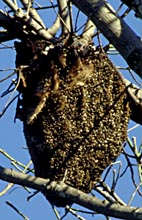
But we also discovered another large, potential problem. In the tropics, some crops are grown year-around, and the growing season is not necessarily linked to the time of year. So just because a field has a crop of sugarcane that's ready to be harvested in March of this year does not mean that it will be ready to harvest in March of next year or March of last year.
Sallie's photos were taken at roughly the same time of year we were there, but two years previously. So just because we found mature sugarcane on the ground did not mean that the photo represented mature sugarcane two years ago. Obviously Sallie is going to have to get a photo of the site taken at approximately the time we were there. This wouldn't seem so hard, since the LANDSAT satellites take a complete set of images of the earth every 16 days, but she also needs an image where there's not too much cloud cover. Near Liberia, this isn't such a big deal, since it was roasting hot every day with almost clear skies, but it may prove to be a problem for some of her other sites. She was planning to do not only sites near Las Cruces and Palo Verde, but also at San Isidro and at La Selva. And it's always wet at La Selva.
We had dinner that night at our hotel "Las Espuelas", and it was pretty bad.
In conjunction with Sallie's project, Gretchen was also having some bird surveys done at the same general sites to see how the biodiversity of birds is affected by the land use. For example, is it much higher if there is a nearby forest patch? What lives in the melon fields? And so on. A few years previously we'd helped with some bird surveys near Las Cruces, and discovered drastic differences amoung the bird counts taken in pasture, coffee, and banana plantations. In the bananas, for example, the only birds you'd see were on the edges, perhaps because they only got into the bananas by mistake.
The guy doing the bird surveys is Jim (mentioned earlier), and it happened that he was doing surveys at Palo Verde for a few of the same days that we'd be there, so we arranged to meet him on the morning after we arrived.
I had met him over lunch a couple of years previously, but had never seen him in action (he was supposed to be a God when it comes to birding), so I was looking forward to the meeting. He's lived in Costa Rica for years, knows the birds backwards and forwards, and in addition, he had been in the Palo Verde region for a couple of weeks now, so he had a very good idea of places to check.
So at 8:00 am the next morning, we drove to the tiny town of Pijije to meet him. That's all the directions we had -- stop on the road in Pijije, and I'll meet you there. Those directions worked just fine.
We piled into his car and went for a ride. Of course we were
primarily interested in sites to measure with our GPS, but
whenever Jim saw a bird, he'd let us know, and in about a day
and a half spent with him we saw about 50 different birds,
and we weren't exactly in prime birdwatching locations -- most
of the time we were in melon fields or something like that.
(The rice paddies, however, do seem to support quite a good
variety of birds.)
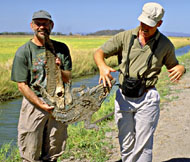
Jim was able to talk our way into a large privately owned farm that had huge melon fields and rice paddies, and in addition, raised lots of cattle. We got free reign to go anywhere inside, and we took full advantage of it. We measured a lot of fields that were so large that we really didn't need the DGPS to assure we'd have some good pixels -- some were 700 meters by 700 meters. We got rice and melons in all stages of development, from pond to rice ready to harvest, and melons from plastic-covered fields with little holes for the plants to emerge to harvest-ready melons. We also stepped on quite a few very ripe melons. Luckily, I still insisted on wearing the rubber boots everywhere.
While Sallie and I were walking around the fields, Jim was able to do a few bird transects of his own, and he fully inteded to go back after we were gone because there was a lot of interesting land on that farm.
Jim was staying at Palo Verde, so we split up and agreed to meet him the next day about halfway between the main road and the OTS station.
We basically spent the entire day on the farm, and had lunch in a little soda for employees. ("Sodas" are sort of like little diners, serving exactly the same thing in each one -- beans and rice, some meat, some salad, and a drink.)
When we returned to Liberia, for dinner, we looked in our tourist guidebooks to figure out a reasonable place and they suggested something that was a little out of town. That was sort of nice, since the week we were there was one giant fiesta in Liberia, with parades, music, traffic blocked, et cetera. The dinner was pretty good, but we'd had a couple of beers with it and that made us brave enough to venture into town for the festivities.
It was pretty loud, a parade was in progress, and the streets
were filled with horsemen all dressed up for some previous
event. Sallie is quite interested in horses, so we spent
some time looking at them. They all seemed to be in very
good shape (this is very different from what I found in Ecuador),
but Sallie said that the various bridles and so on were much
more brutal than those used in England. We did find a nice
restaurant/bar and eventually got a seat on the balcony
where we could watch the goings-on. It was a very nice
place and we decided that we'd have dinner there the next
evening.
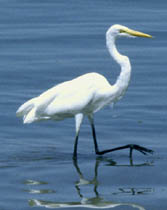
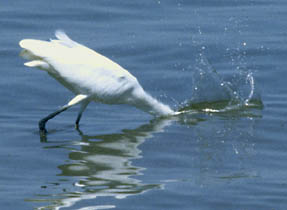
Years previously, Ellyn and I had met a couple of kids, Mauricio and Nicole, when they were attending university and were spending a lot of time doing volunteer work at Palo Verde. We'd kept in touch, and gotten together with them each time we visited Costa Rica, and I had heard that Mauricio had a full-time job at Palo Verde. I asked Jim if he knew Mauricio, and he said of course he did -- Mauricio was the chief administrator at the station, and that his girlfriend, Nicole, was leading the nature tours. So at that point I was pretty confident that we'd get to eat lunch at the station.
We walked into the station headquarters, and Mauricio was, of course, completely surprised to see me. He said we were of course welcome to stay for lunch, and checked to make sure that we could stay there for the final three nights. Usually to stay at an OTS station you arrange everything through the main office in San José, but Mauricio said he'd call them and set everything up. There was a minor glitch and I was Jim's roommate for one night, but that was a lot better than staying at Liberia. It was a glitch because Jim gets up at 4:30 am to do his birds, and it's hard to sleep throuh an alarm. Luckily, I was able to go back to sleep and wake up at a "decent" 5:45 am.
Shortly after we arrived in the office, Sallie got a surprise. Nicole arrived in a truck with some tourists and walked into the office. When she saw me she gave a delighted squeal and gave me a big hug. She's seen a lot more of me than of Ellyn, since Ellyn hadn't been to Costa Rica for a couple of years, and Sallie is about Ellyn's height and her hair is the same color, but she wasn't expecting to get the next big hug from Nicole.
Anyway, we had lunch, but couldn't stay around for too long since we had sites to do. We told Nicole and Mauricio we'd stay in Liberia for one more night, and would be back in Palo Verde before dinner the next evening.
On the way to the station, I had noticed that the level of the gasoline gauge on the car was taking some weird and wild jumps, and would settle down uncomfortably close to the "empty" mark. The car didn't have an idiot light warning of low fuel, and I really wasn't sure how much more we had. From Palo Verde, it's about 30 kilometers on rough road to the nearest gas station in the town of Bagaces, so I told Sallie that I'd prefer to head straight back to Bagaces doing sites, and not to wander around looking for stuff; we could do plenty of that when we were spending our three days at the station.
Jim had the same kind of rental car, and assured us that he'd seen his gas gauge below "empty", but had no idea how close he had been to running out. We did get back to the station at Bagaces without incident (and with the gauge pointing exactly at "empty"), but noted that it only took 38 liters to fill the tank, whereas the owner's manual stated that the tank held 46 liters. That was good to know.
We went into town to find the restaurant where we'd had beers the previous night, but it was Saturday night, the high point of the fiesta, and approaching it looked pretty ugly. We wandered around on the streets a bit and found yet another Chinese restaurant, so we gave it a shot, even though it's not mentioned in any of the guides. I had a shrimp meal that was probably one of the best I've had in Costa Rica. It was even better than the "wooba".
It took a while, but it wasn't bad. We just walked in sugarcane
fields, and it was quite easy to walk around the whole thing. It
was almost rectangular, with a couple of rectangular corners
chopped out. I have no idea why it was left standing -- everything
else, as far as the eye could see, was sugarcane.
By now it was Sunday, and when we drove back to Filadelfia we couldn't find any open restaurants. After wandering around quite a bit, we did find an open soda next to the bus station. In order to balance out the best meal ever in Costa Rica, this soda provided one of the worst meals ever. But it was all we could find.
We worked a bit later than we should have, considering that we had to make it to Palo Verde by 6:00 pm for dinner, and in addition, we wanted to make sure we had some critical supplies there -- Sallie wanted some bottled water and I wanted a box of wine or something. The OTS station there is in a national park, so they can't sell alcohol, and having become accustomed to a few beers every evening, we didn't want to take any chances of having to go cold turkey. We had gotten 24 cans of beer the night before, but I was worried that we might have to share it with a lot of people, so I wanted a box or two of wine in case we ran out.
So on Sunday evening at about 4:30 pm we finally got to Liberia, and couldn't find an open grocery store. Finally, we spotted what looked like a big one, so I got out and Sallie stayed in the car to guard it, since it contained everything we owned, and we knew just how easy it was to break into a rental car.
It wasn't a grocery store -- it was like one of those huge discount places -- Costco or something. I couldn't get bottles of water for Sallie; only giant 4-liter bottles. I coudn't find any wine, either, so I grabbed a bottle of rum. Then I got to the checkout lines and discovered that they're just like the checkout lines in Costo in the United States -- everybody is buying huge amounts of stuff, so there are long lines and full carts in front of you. It took 20 minutes to get through the line, and we left for Palo Verde with only an hour left before dinner.
The first 20 kilometers to the turn-off at Bagaces were easy, but the last 30 on a bumpy dirt road weren't. Sallie was driving, however, and did a great job. When hungry gringos are headed toward food, we can be pretty aggressive. We got there at almost exactly 6:00.
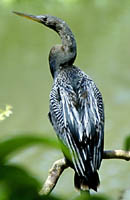
When we were on the trail in Carara, just about ready to take the
short detour in to see the pond, we met a fairly large tour group
coming out. One of the women was looking in the index of her bird
guide, and asked her friend, "Is it spelled 'a-n-n'?" I hadn't even
seen the bird, but since we were heading for water it was pretty easy
to guess what she was talking about, so I interrupted and said, "It's
'a-n-h'."
There were a couple of tourists at Palo Verde at all times, but a big group of high school students showed up who were taking an OTS tropical biology course. They worked hard and tended to eat a lot, so it would have been a very bad idea to be more than a couple of minutes late to dinner. In fact, one evening both Nicole and Mauricio were missing when dinner started, and we learned that they were out looking for a couple of lost kids who finally dragged in about 15 minutes late. In fact, some food was saved for them, but we certainly joked about gobbling it all down, and when they did show up, telling them, "Of course we ate your food. We thought you were dead."
Of course both Sallie and I had recently read a study that showed that people who are completely incompetent are the ones most certain of their ability, and it led to quite a series of jokes (just between the two of us). "Yes. I'm great. I really know I'm great. There's no doubt about it."
(Of course I'm a rare exception to that rule. I am a really great photographer and I know it, too.)
We couldn't fit her bike into the car with all the rest of us and our junk, so we wheeled it into the forest and hid it pretty well. She's a (young) undergraduate at Lawrence College in Wisconson or someplace who was doing a semester project in Costa Rica studying cattle. She was staying with a family in a tiny town called Bagatzi that consists of about 30 families, and she was biking from there to Palo Verde every day. She was all by herself, and it seemed to us like a pretty risky project to assign to somebody like that.
Well, at least she was better prepared than I was when I entered that forest patch near Las Cruces -- I noticed that her backpack was almost empty, but it did contain a machete.
We took her back to Bagatzi and made a careful note of the mileage (or rather kilometerage) back to her bike. I hope she does OK.
About an hour later I found my jacket and the bed soaked in ice water. The sheets on the bed were perfectly clean and white beforehand, but the mattress underneath was pretty old, and the water leached out quite a bit of yellowish stain that spread over the sheet. It sure looked like I'd had quite an accident with some yellowish fluid. But it was right at the head of the bed, so I either must have slept in an extremely strange position, or had one heck of a drooling problem and chewed a lot of tobacco, besides.
The night after that incident, there was another minor housing glitch. My room had four beds and one person, and they needed to house a couple of emergency guests, so I was moved to a room with a single bed. Sallie was convinced that the story of the emergency guests was a fake, and what they were really trying to do is move me to a room with rubber sheets.
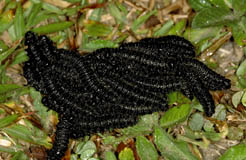
They moved as a group, with caterpillars from the rear crawling over the
others to arrive at the front, where they'd stop, and the process
repeated. Unfortunately, it was like a group of lemmings, since they
were headed for the road, which had a fair amount of traffic. In
this case, their genetic programming led the entire group to disaster,
since later in the day I just found a black smear on the road near
where I'd seen the clumps earlier. The naturalist at Wilson claimed
these were wasp larvae, but I don't believe him -- I think they're
lepidopterans of some sort.
Now a glowing caterpillar is pretty strange -- normally insects like fireflies turn on the light (and possibly attract preditors) to find a mate. A larva (it was not really a caterpillar, but a beetle larva, we think) is not ready to mate, so it would seem nuts to advertise it's position at night by glowing. There were even a couple of professional entomologists staying there (to give some classes to the high school kids) and they had never heard of anything like it.
The larva also had some other aposomatic coloring (warning colors that indicate that it's possibly poisonous), so perhaps the light is another sort of aposomatic signal. In any case, Mauricio took the larva and some of the leaves he found it on, and will try to raise it to an adult to see what it is.
But we did do a lot of driving while we were there. We went outside the park a few times to get some of the local rice paddies which were constructed and used quite differently from those on the giant industrialized farm we'd visited earlier.
In any case, by the time we left for San José, the gas gauge was truly pointing at zero. But miraculously, there were still about four liters left when we got to Bagaces.
Other than the first 30 kilometers (Palo Verde to Bagaces), the trip
to San José were pretty uneventful. To break the boredom
of the Pan American Highway a bit we took some back roads, and
although it wasn't quite as fast, it was a lot prettier. We
got to San José at about noon.
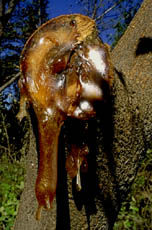
It also reminds me of Sallie's joke, but with the wrong answer.
The joke: "What's brown and sticky?" The "correct" answer:
"A stick."
When we entered the lobby of the hotel, some of the guests were
whining about the repeated power outages the city had been
experiencing of late, but I thought nothing of it.
But when Sallie had tried to check out at Palo Verde, she discovered that her credit card (a corporate credit card issued by Stanford) was overdrawn. What had happened is that she'd gotten about $2000 in traveller's checks and it had been charged to her account rather than to some other one. Stanford had promised to fix the problem, but apparently they still hadn't, more than two weeks later.
She was not looking forward to two more weeks without a credit card and the possibility that she'd have to pay for the car (probably more than $2000 after a full month rental) at the end. I said I had about $500 in traveller's checks that she was welcome to borrow, and at least make things a little less risky. She accepted, so I went across the street to the bank to cash them while she waited with our luggage for the rooms (we'd arrived early and the rooms were not quite ready).
But financial computers don't do well with fluctuating power, and the bank was closed, and had been for quite some time. They couldn't access the financial records with the computers down.
The limit for changing traveller's checks at the hotel was $100, so I did that. Then Sallie and I went downtown in search of some topographic maps of San Isidro that had been misplaced somewhere between Stanford and Liberia. We actually were able to purchase 4 of the 6 maps she needed, and then went looking for a bank at about 2:30 (most of them close at 3:00). We found a private bank that was open, and I cashed the other $400 in credit cards. It was a little weird walking back to the hotel feeling like an unguarded armored truck, but we got there without incident.
We had dinner at the gay restaurant, and at least I was asleep by 8:30.
The traffic is pretty complicated in San José and Sallie wasn't too intrested in trying to find her way out by herself, so I volunteered to get up early and drive her out past the worst of the traffic and then I'd take a bus back to the hotel where I'd get a taxi to the airport. We got up at 5:00 am, drove to the "city limits", Sallie took off, and I walked to a bus stop, but a taxi showed up and I just took that.
There were the usual problems and delays getting home, but I arrived only a couple of hours late.
Want to send me mail? Click here: tomrdavis@earthlink.net.
Return to my home page